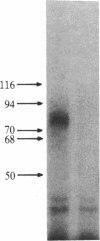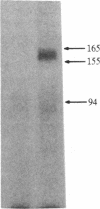Abstract
In this study, a monoclonal antibody (mAb) termed SN6 was generated by immunizing a mouse with a non-T-cell leukemia antigen preparation isolated from cell membranes of leukemia cells derived from a patient (FJ) with non-T/non-B-cell-type acute lymphoblastic leukemia (ALL). SN6 was tested against a variety of cultured and uncultured human cell specimens by using a sensitive cellular radioimmunoassay. Among the 26 cultured malignant and nonmalignant cell lines tested, SN6 reacted with all of the 6 leukemic non-T/non-B (including pre-B)-cell lines tested--i.e., KM-3, NALM-16, REH, NALL-1, NALM-1, and NALM-6. Of these cell lines, 5 were derived from individual patients with ALL; the remaining 1 was from a patient with chronic myelocytic leukemia in blast crisis. In addition, SN6 reacted with 3 of 3 leukemic myelo-monocytic cell lines tested--i.e., ML-2, HL-60, and U937. SN6 did not react with any other cell lines. A consistent result was obtained with 42 fresh (uncultured) cell specimens derived from individual patients with several different types of leukemias. SN6 reacted with 11 of 16 non-T/non-B (including pre-B)-cell ALL specimens. In addition, it reacted with various myelo-monocytic leukemia cell specimens to various degrees. SN6 did not show a significant reaction with normal peripheral blood cells tested, which included B cells, T cells, granulocytes, monocytes, and erythrocytes. However, it reacted with a small population (approximately 1% as determined by immunofluorescence staining) of normal bone marrow cells. The approximate molecular mass of the glycoprotein antigen defined by SN6 was determined to be 160,000 by radioimmunoprecipitation followed by sodium dodecyl sulfate/polyacrylamide gel electrophoresis. Only one component of 80,000 daltons was formed upon reduction of the 160,000 molecular mass antigen. Therefore, this antigen is apparently a homodimer of a 80,000-dalton subunit. This conclusion was further corroborated by two-dimensional gel analysis, which showed a single well-defined spot for the reduced antigen. We designate this distinct human leukemia-associated cell surface antigen "GP160."
Full text
PDF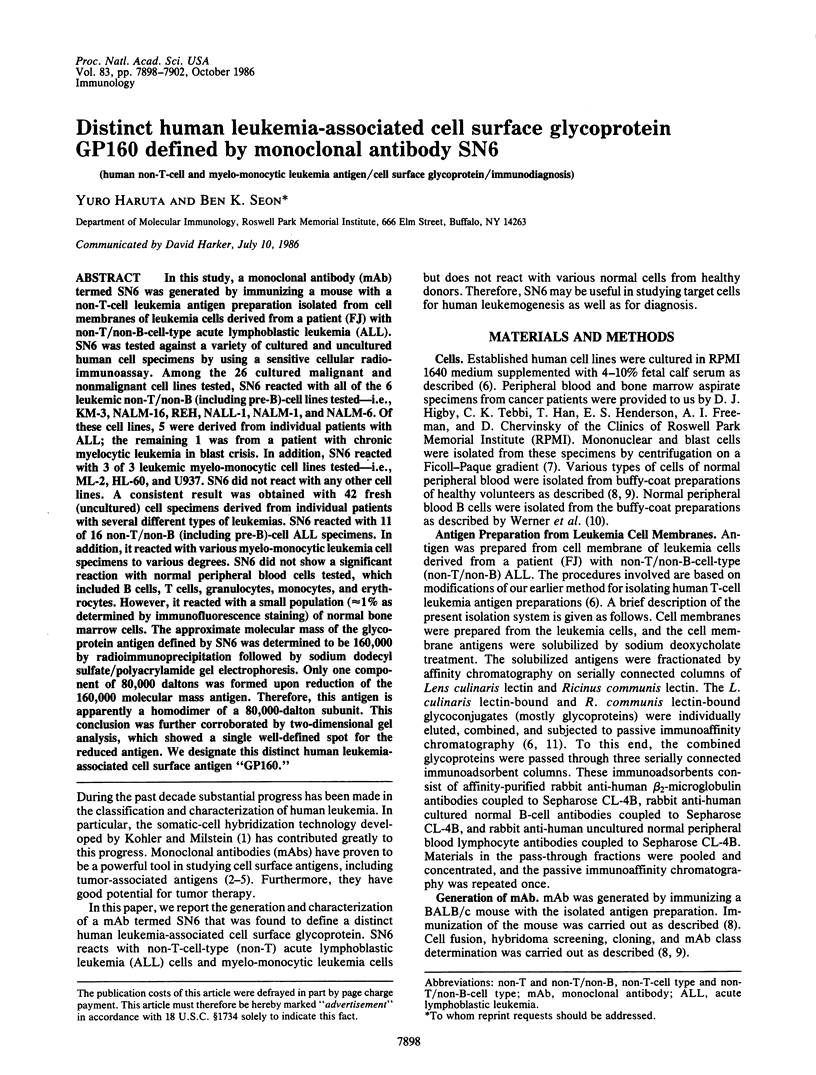
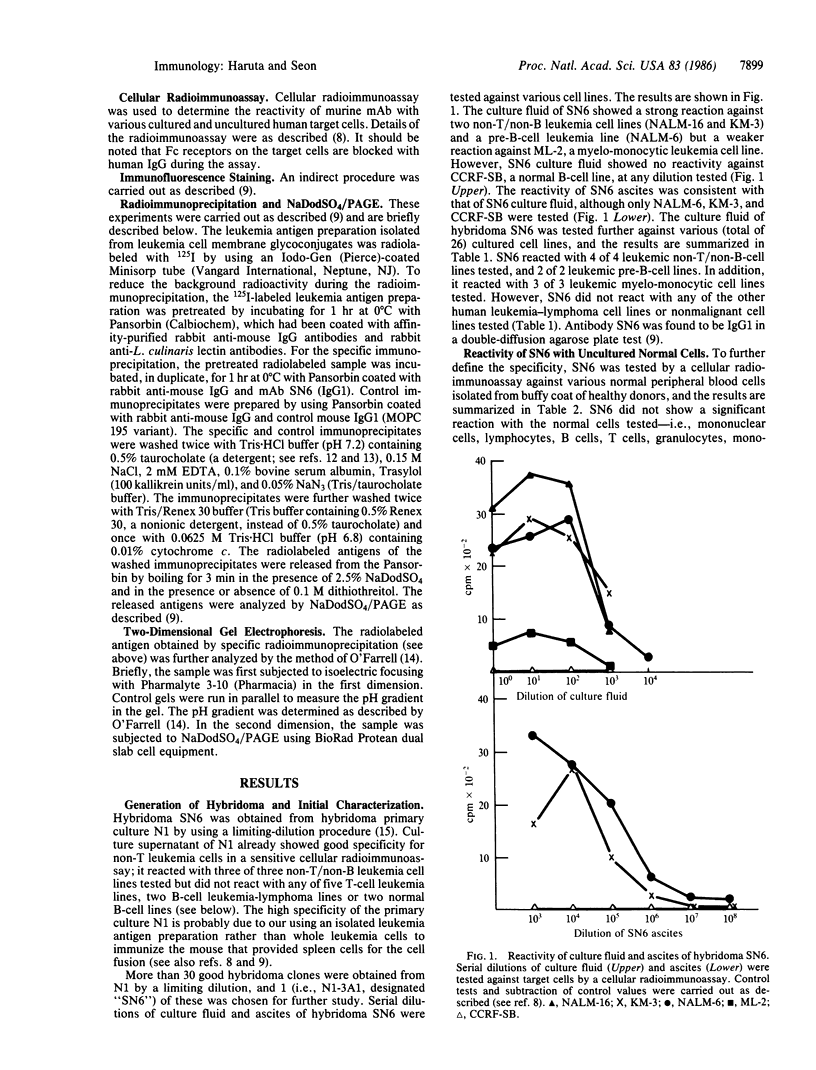
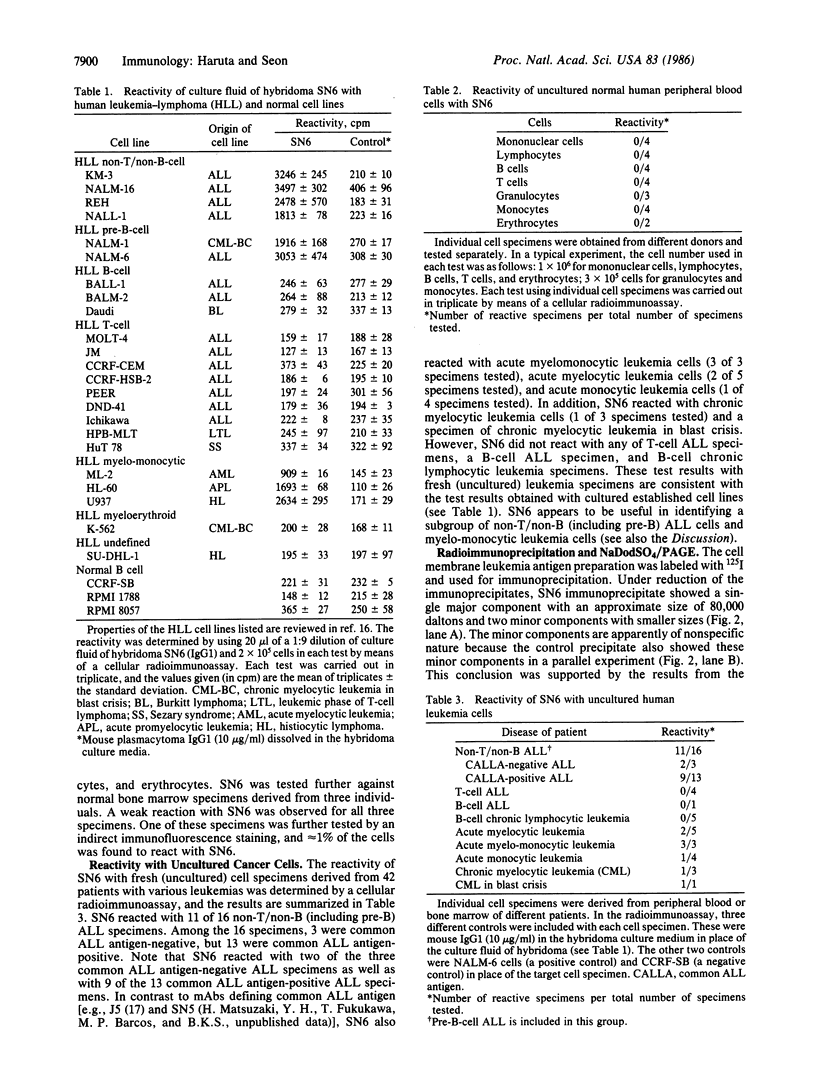
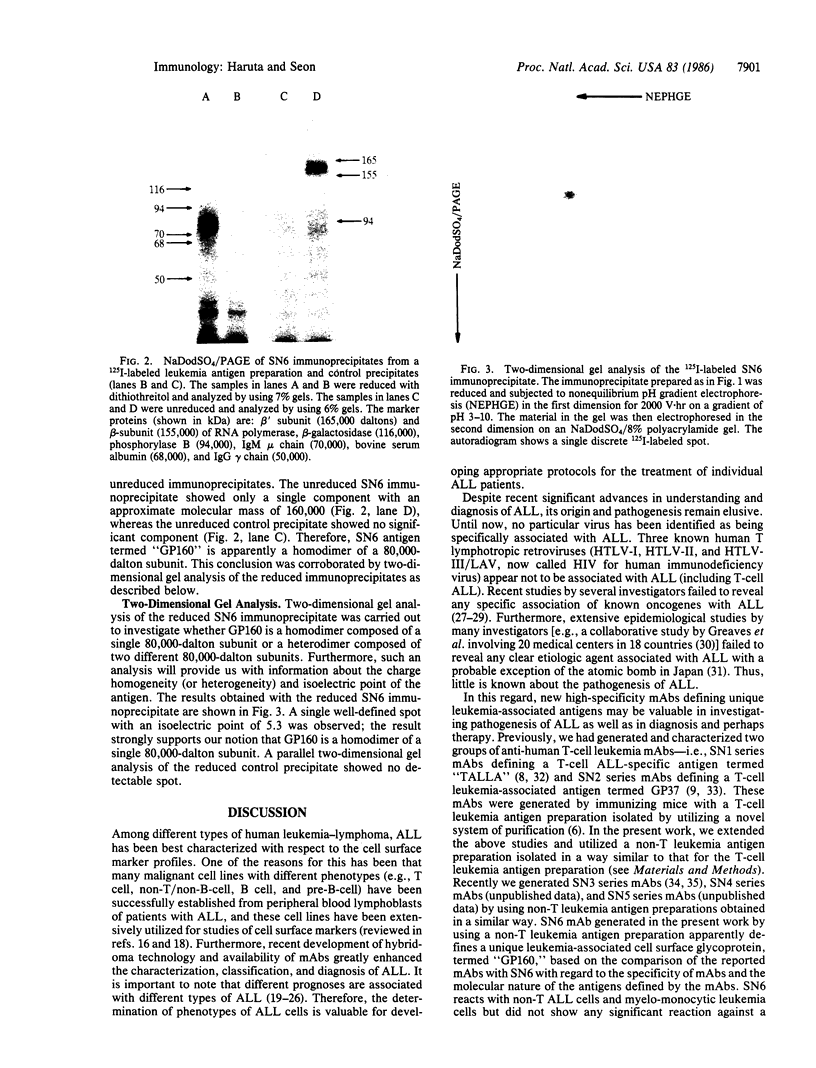
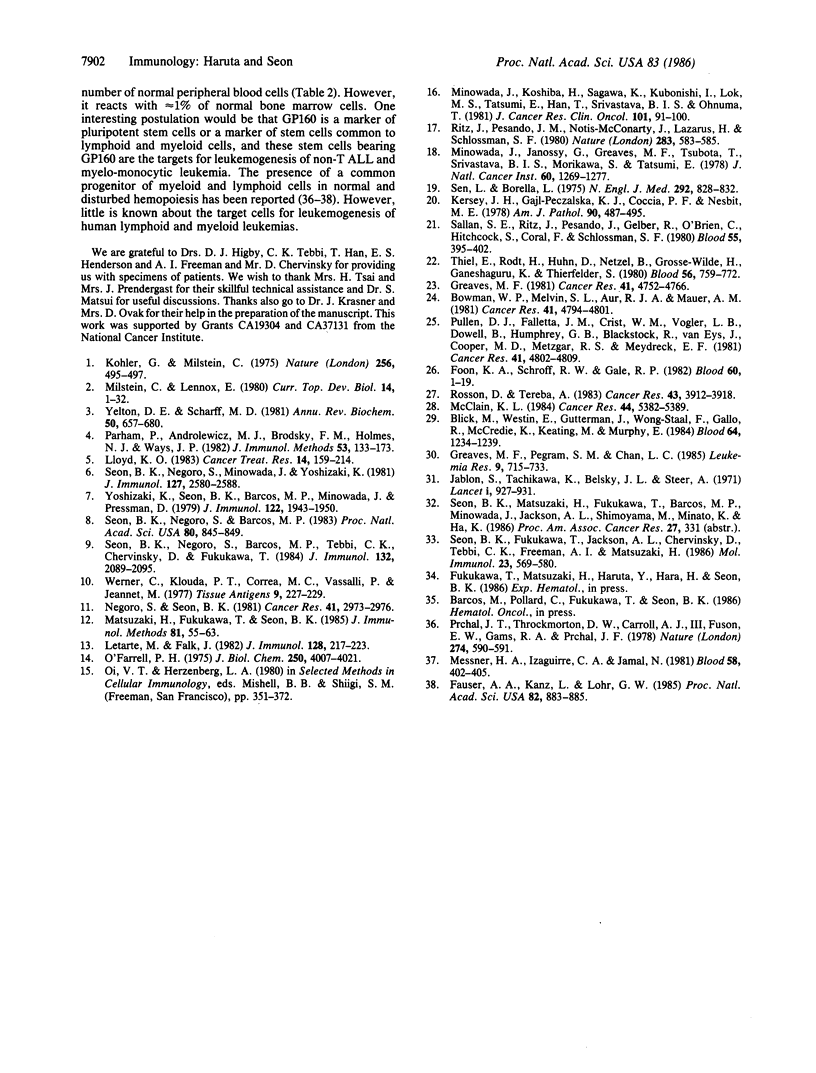
Images in this article
Selected References
These references are in PubMed. This may not be the complete list of references from this article.
- Blick M., Westin E., Gutterman J., Wong-Staal F., Gallo R., McCredie K., Keating M., Murphy E. Oncogene expression in human leukemia. Blood. 1984 Dec;64(6):1234–1239. [PubMed] [Google Scholar]
- Bowman W. P., Melvin S. L., Aur R. J., Mauer A. M. A clinical perspective on cell markers in acute lymphocytic leukemia. Cancer Res. 1981 Nov;41(11 Pt 2):4794–4801. [PubMed] [Google Scholar]
- Fauser A. A., Kanz L., Löhr G. W. Identification of B cells in multilineage hematopoietic colonies derived from cells of patients with lymphocytic lymphoma. Proc Natl Acad Sci U S A. 1985 Feb;82(3):883–885. doi: 10.1073/pnas.82.3.883. [DOI] [PMC free article] [PubMed] [Google Scholar]
- Foon K. A., Schroff R. W., Gale R. P. Surface markers on leukemia and lymphoma cells: recent advances. Blood. 1982 Jul;60(1):1–19. [PubMed] [Google Scholar]
- Greaves M. F. Analysis of the clinical and biological significance of lymphoid phenotypes in acute leukemia. Cancer Res. 1981 Nov;41(11 Pt 2):4752–4766. [PubMed] [Google Scholar]
- Greaves M. F., Pegram S. M., Chan L. C. Collaborative group study of the epidemiology of acute lymphoblastic leukaemia subtypes: background and first report. Leuk Res. 1985;9(6):715–733. doi: 10.1016/0145-2126(85)90281-4. [DOI] [PubMed] [Google Scholar]
- Jablon S., Tachikawa K., Belsky J. L., Steer A. Cancer in Japanese exposed as children to atomic bombs. Lancet. 1971 May 8;1(7706):927–932. doi: 10.1016/s0140-6736(71)91438-3. [DOI] [PubMed] [Google Scholar]
- Kersey J. H., Gajl-Peczalska K. J., Coccia P. F., Nesbit M. E. The nature of childhood leukemia and lymphoma. Am J Pathol. 1978 Feb;90(2):487–495. [PMC free article] [PubMed] [Google Scholar]
- Köhler G., Milstein C. Continuous cultures of fused cells secreting antibody of predefined specificity. Nature. 1975 Aug 7;256(5517):495–497. doi: 10.1038/256495a0. [DOI] [PubMed] [Google Scholar]
- Letarte M., Falk J. Biochemical and immunologic heterogeneity of Ia glycoproteins isolated from a chronic lymphocytic leukemia. J Immunol. 1982 Jan;128(1):217–223. [PubMed] [Google Scholar]
- Matsuzaki H., Fukukawa T., Seon B. K. Simple solid-phase radioimmunoassay for human leukemia-associated cell membrane antigens. J Immunol Methods. 1985 Jul 16;81(1):55–63. doi: 10.1016/0022-1759(85)90121-8. [DOI] [PubMed] [Google Scholar]
- McClain K. L. Expression of oncogenes in human leukemias. Cancer Res. 1984 Nov;44(11):5382–5389. [PubMed] [Google Scholar]
- Messner H. A., Izaquirre C. A., Jamal N. Identification of T lymphocytes in human mixed hemopoietic colonies. Blood. 1981 Aug;58(2):402–405. [PubMed] [Google Scholar]
- Milstein C., Lennox E. The use of monoclonal antibody techniques in the study of development cell surfaces. Curr Top Dev Biol. 1980;14(Pt 2):1–32. doi: 10.1016/s0070-2153(08)60187-8. [DOI] [PubMed] [Google Scholar]
- Minowada J., Janossy G., Greaves M. F., Tsubota T., Srivastava B. I., Morikawa S., Tatsumi E. Expression of an antigen associated with acute lymphoblastic leukemia in human leukemia-lymphoma cell lines. J Natl Cancer Inst. 1978 Jun;60(6):1269–1277. doi: 10.1093/jnci/60.6.1269. [DOI] [PubMed] [Google Scholar]
- Minowada J., Koshiba H., Sagawa K., Kubonishi I., Lok M. S., Tatsumi E., Han T., Srivastava B. I., Ohnuma T. Marker profiles of human leukemia and lymphoma cell lines. J Cancer Res Clin Oncol. 1981;101(1):91–100. doi: 10.1007/BF00405069. [DOI] [PubMed] [Google Scholar]
- Negoro S., Seon B. K. Strong, specific anti-human leukemia antisera prepared with the use of purified cell membrane antigen. Cancer Res. 1981 Jul;41(7):2973–2976. [PubMed] [Google Scholar]
- O'Farrell P. H. High resolution two-dimensional electrophoresis of proteins. J Biol Chem. 1975 May 25;250(10):4007–4021. [PMC free article] [PubMed] [Google Scholar]
- Parham P., Androlewicz M. J., Brodsky F. M., Holmes N. J., Ways J. P. Monoclonal antibodies: purification, fragmentation and application to structural and functional studies of class I MHC antigens. J Immunol Methods. 1982 Sep 17;53(2):133–173. doi: 10.1016/0022-1759(82)90137-5. [DOI] [PubMed] [Google Scholar]
- Prchal J. T., Throckmorton D. W., Carroll A. J., 3rd, Fuson E. W., Gams R. A., Prchal J. F. A common progenitor for human myeloid and lymphoid cells. Nature. 1978 Aug 10;274(5671):590–591. doi: 10.1038/274590a0. [DOI] [PubMed] [Google Scholar]
- Pullen D. J., Falletta J. M., Crist W. M., Vogler L. B., Dowell B., Humphrey G. B., Blackstock R., Eys J. V., Cooper M. D., Metzgar R. S. Southwest Oncology Group experience with immunological phenotyping in acute lymphocytic leukemia of childhood. Cancer Res. 1981 Nov;41(11 Pt 2):4802–4809. [PubMed] [Google Scholar]
- Ritz J., Pesando J. M., Notis-McConarty J., Lazarus H., Schlossman S. F. A monoclonal antibody to human acute lymphoblastic leukaemia antigen. Nature. 1980 Feb 7;283(5747):583–585. doi: 10.1038/283583a0. [DOI] [PubMed] [Google Scholar]
- Rosson D., Tereba A. Transcription of hematopoietic-associated oncogenes in childhood leukemia. Cancer Res. 1983 Aug;43(8):3912–3918. [PubMed] [Google Scholar]
- Sallan S. E., Ritz J., Pesando J., Gelber R., O'Brien C., Hitchcock S., Coral F., Schlossman S. F. Cell surface antigens: prognostic implications in childhood acute lymphoblastic leukemia. Blood. 1980 Mar;55(3):395–402. [PubMed] [Google Scholar]
- Sen L., Borella L. Clinical importance of lymphoblasts with T markers in childhood acute leukemia. N Engl J Med. 1975 Apr 17;292(16):828–832. doi: 10.1056/NEJM197504172921604. [DOI] [PubMed] [Google Scholar]
- Seon B. K., Fukukawa T., Jackson A. L., Chervinsky D., Tebbi C. K., Freeman A. I., Matsuzaki H. Human T-cell leukemia-associated cell surface glycoprotein GP37: studies with three monoclonal antibodies and a rabbit antiserum. Mol Immunol. 1986 Jun;23(6):569–580. doi: 10.1016/0161-5890(86)90093-3. [DOI] [PubMed] [Google Scholar]
- Seon B. K., Negoro S., Barcos M. P. Monoclonal antibody that defines a unique human T-cell leukemia antigen. Proc Natl Acad Sci U S A. 1983 Feb;80(3):845–849. doi: 10.1073/pnas.80.3.845. [DOI] [PMC free article] [PubMed] [Google Scholar]
- Seon B. K., Negoro S., Barcos M. P., Tebbi C. K., Chervinsky D., Fukukawa T. Monoclonal antibody SN2 defining a human T cell leukemia-associated cell surface glycoprotein. J Immunol. 1984 Apr;132(4):2089–2095. [PubMed] [Google Scholar]
- Seon B. K., Negoro S., Minowada J., Yoshizaki K. Human T cell leukemia antigens on the cell membranes: purification molecular characterization, and preparation of specific antisera. J Immunol. 1981 Dec;127(6):2580–2588. [PubMed] [Google Scholar]
- Thiel E., Rodt H., Huhn D., Netzel B., Grosse-Wilde H., Ganeshaguru K., Thierfelder S. Multimarker classification of acute lymphoblastic leukemia: evidence for further T subgroups and evaluation of their clinical significance. Blood. 1980 Nov;56(5):759–772. [PubMed] [Google Scholar]
- Werner C., Klouda P. T., Corréa M. C., Vassalli P., Jeannet M. Isolation of B and T lymphocytes by nylon fiber columns. Tissue Antigens. 1977 Apr;9(4):227–229. doi: 10.1111/j.1399-0039.1977.tb01112.x. [DOI] [PubMed] [Google Scholar]
- Yelton D. E., Scharff M. D. Monoclonal antibodies: a powerful new tool in biology and medicine. Annu Rev Biochem. 1981;50:657–680. doi: 10.1146/annurev.bi.50.070181.003301. [DOI] [PubMed] [Google Scholar]
- Yoshizaki K., Seon B. K., Barcos M. P., Minowada J., Pressman D. Detection and characterization of human leukemia-associated antigens on leukemic cell lines and thymocytes. I. Characterization of baboon and rabbit antisera to MOLT-4. J Immunol. 1979 May;122(5):1943–1950. [PubMed] [Google Scholar]



